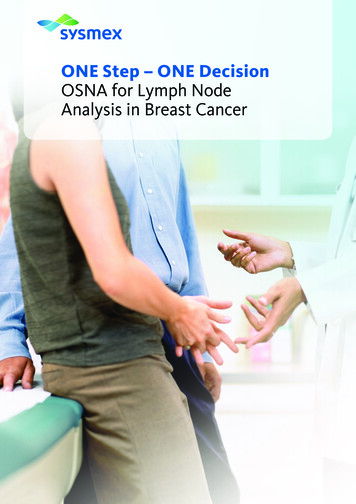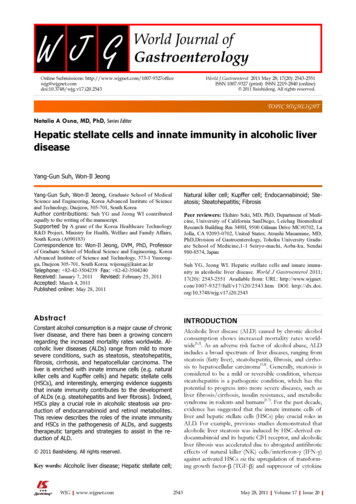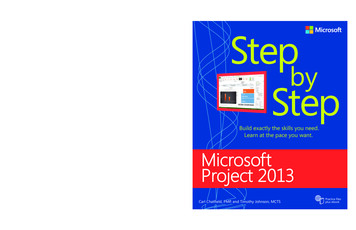
Transcription
ONE Step – ONE DecisionOSNA for Lymph NodeAnalysis in Breast Cancer
OSNA – ONE step aheadSentinel lymph node (SLN) biopsy hasrapidly emerged as a minimally invasiveand accurate method of axillary stagingin patients with early-stage breast cancerand has become the standard of care inmany countries worldwide. Unnecessaryaxillary lymph node dissections can beavoided resulting in fewer complicationsfor patients.Intra-operative examination of the SLNusing conventional cellular pathologymethods was introduced to further benefit patients by making one-step surgery arealistic possibility. However, intra-operative methods such as touch imprint cytology or frozen section suffer from a lack ofsensitivity and are not standardised, thusproviding a considerable number of falsenegative patient results. A significant number of metastases can only be detectedlater by more detailed post-operativeanalysis. These patients in general needto undergo avoidable second surgeries.ONE System – ONE MarkerFurthermore, recent findings concerning the clinical relevance of metastasesin SLNs require a clear picture of the extent of tumour burden and reliable andstandardised results for a more accuratestaging.Sysmex have created a new diagnosticdimension with the OSNA moleculardiagnostic assay. In contrast to the conventional methods, analysis of the complete lymph node with OSNA provides ahighly accurate result supporting a finalclinical decision even in an intra-operative timeframe.OSNA (One Step Nucleic Acid Amplification)is an isothermal procedure using a rapid nucleicacid amplification technology (RT-LAMP * ) todetect the expression level of Cytokeratin 19(CK19) mRNA. Cytokeratin 19, an epithelial cellmarker, is normally not present in lymph nodetissue. Six primers for high levels of specificityand sensitivity have been specifically designedthus allowing the use of a single marker withoutamplification of pseudogenes. Furthermore falsepositive results are avoided because the use ofan isothermal method prevents amplificationof genomic DNA.Lymph node tissue is simply homogenised andno prior purification of RNA is required. Thesamples are inserted into the RD-100i automatedreal time detection system providing fast, accurate and standardised results. Up to 4 lymphnodes can be analysed in parallel and results areavailable in about 30–40 minutes dependingon the number of SLN analysed.The quantitative measurement of the CK19marker not only allows differentiation betweena positive and a negative result. It also gives anindication for the size of the metastatic tumourburden. The amplification reaction takes 16 minutes and is monitored in real time. Results aredisplayed in three categories with a direct relation to the measured copy numbers of CK19mRNA:( ) macrometastatic tumour burden( ) micrometastatic tumour burden(–) no metastasesThe method is also applicable to lymph nodeanalysis of patients after neoadjuvant therapy(PST) for whom a SLNB is indicated.OSNA is CE-marked and compliant with the invitro diagnostic directive 98/79/EC. It is thusapproved for diagnostic use throughout Europe.nn( * RT-LAMP reverse transcriptase loop-mediatedisothermal amplification; licensed under the agreementof Eiken Chemical Co., Ltd)nfast, intra-operative decisionautomated and standardised procedurealso for patients after PST
ONE Method – ONE StandardOSNA offers a new standard of care inbreast cancer for lymph node testing.Many investigators have reported thatintra-operative techniques such as imprint cytology or frozen section have lowsensitivity due to the limited amount oflymph node tissue that can be analysedin a short timeframe. False negative ratesare significant and, as a consequence, asignificant number of patients need toundergo second surgeries after a positivesubsequent post-operative examination.On the other hand, patients with very lowmetastatic nodal involvement, to whomaxillary dissection could be spared, can beidentified with this test.* IHC immunohistochemistryFor OSNA worldwide evaluations haveshown sensitivity and specificity of over96% in a comparison to extensive postoperative analysis by analysing alternating slices of one lymph node. As a result,many centres are now using OSNA inroutine and patients benefit from an immediate and reliable diagnosis. Importantly, the proportion of the lymph nodetested can be controlled according tolocal policy. Under optimum circumstances where whole node analysis is performed and a definite result has beenobtained with OSNA, post-operativein-vestigation can be abandoned. Thisleads to a reduction in work-load andcosts as intensive sectioning and IHC *are avoided.ONE Step – ONE DecisionOSNA does not require the expertise of amolecular biologist. The test can be easilyimplemented in any institution.nnnnhigher sensitivity than conventionalintra-operative techniquesindication for the size of metastatictumour burdenautomated system, easy to operatereduced pathology workloadRapid detection of sentinel lymph node metastases in breast cancer patients enables an immediatedecision to proceed to axillary lymph node dissection, where indicated. This spares patients a secondanaesthetic and operative procedure, is technically easier, and decreases psychological stress for manypatients. The OSNA result in the form of the CK19 mRNA copy number gives an indication for the sizeof metastasis in the lymph node and enables prediction of further axillary lymph node involvement. Thisallows the surgeon to take a differential decision on the appropriate surgical approach and constitutesan additional parameter to faciliacte decision making on necessary adjuvant therapy and radiotherapyregimens. Omission of post-operative analysis leads to faster and final therapeutic measures.nnnnnnnenhanced staging of the patientimmediate and reliable intra-operative decisionimmediate reconstruction possiblereduced number of second surgeriesreduced waiting time and patient stressassessment of the axillary statusearlier start of treatment
ONE Patient – ONE GoalUsing OSNA can offer a real competitive advantage for the hospital since breast cancer patientsmay prefer a hospital using this innovativemethod. The patients will receive very fast andaccurate sentinel lymph node analysis in onestep. Therefore they will not need to wait forfinal post-operative results days after the firstsurgery with the accompanying risk of beingrecalled for axillary clearance. Without thiswaiting time and within a more personalisedtreatment concept, the psychological pressureon the patient will be reduced and as a resultOSNA increases quality of life.ONE Budget – ONE Aimnnnsuperior quality of patient managementmuch lower psychological pressurefor the patientimproved quality of lifeIn addition to clinical and procedural benefits that OSNA’s innovativetechnology brings to breast cancer patients there are marked financialadvantages from avoiding second surgeries and extensive post-operativeanalysis. Processes can be optimised and high-value resources can focuson other urgent needs. More patients can be treated during the sametime saved in the theatre. Substantial bed days are saved.nnnnnnsignificant reduction of second surgeriesoptimised utilisation of theatre timereduced number of bed staysoptimised resourcesmore patients treatedreal competitive advantage for healthcareinstitutionsONE question left – or more?Find out about the potential savings from using OSNA in your hospital.We are able to offer an individual economic case analysis for all sites.Please consult your local representative for further details.
ZE000241.EN.C.04/15Sysmex UK Ltd.Sysmex House, Garamonde Drive, Wymbush, Milton Keynes, MK8 8DF, United Kingdom · Phone 44 870 902 921 0 · Fax 44 870 902 921 · info@sysmex.co.uk · www.sysmex.co.ukSysmex Europe GmbHBornbarch 1, 22848 Norderstedt, Germany · Phone 49 40 527 26 0 · Fax 49 40 527 26 100 · www.sysmex-lifescience.com
OSNA – ONE step ahead OSNA (One Step Nucleic Acid Amplification) is an isothermal procedure using a rapid nucleic acid amplification technology (RT-LAMP*) to detect the expression level of Cytokeratin 19 (CK19) mRNA. Cytokeratin 19, an epithelial cell marker, is normally not present in lymp











